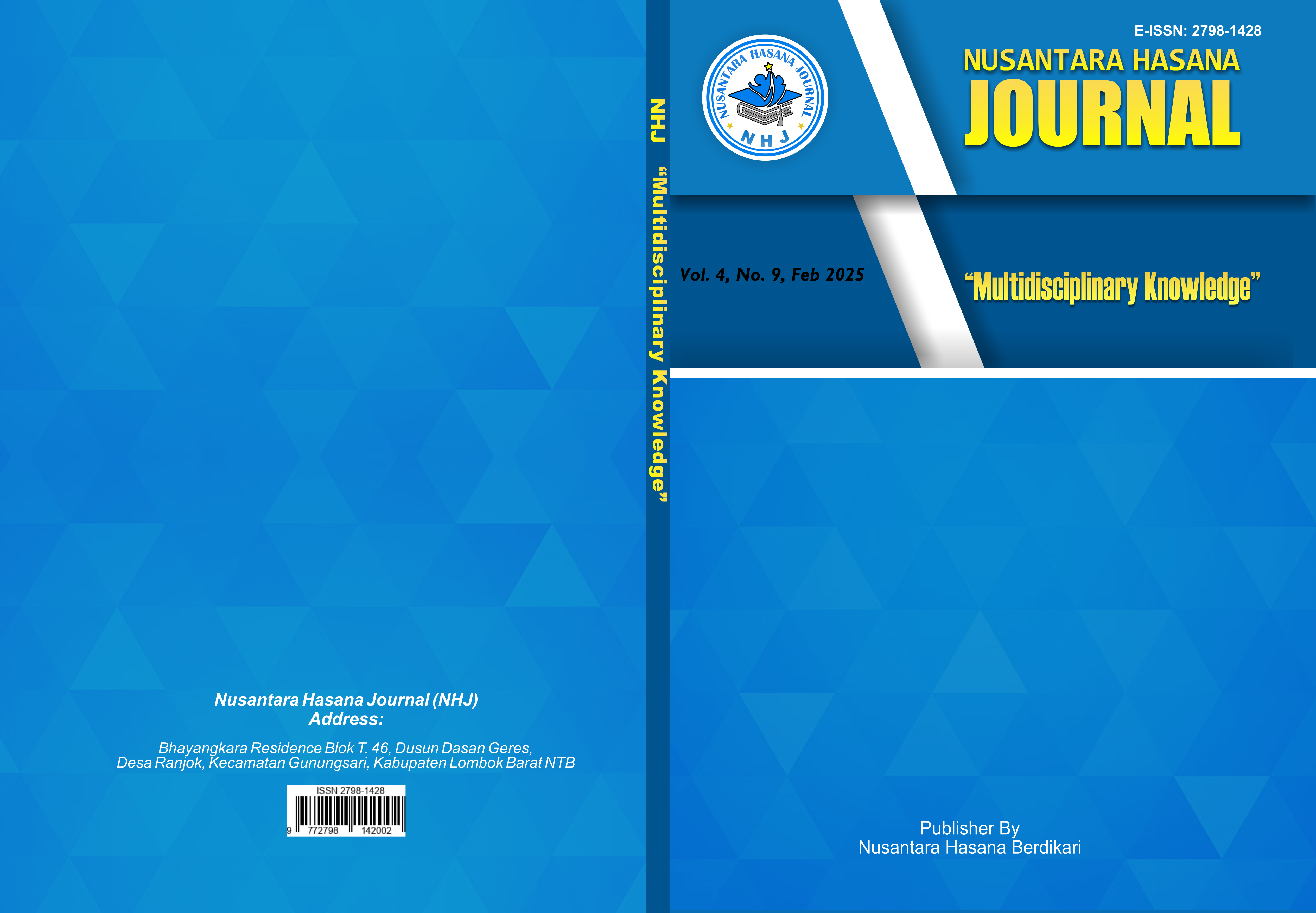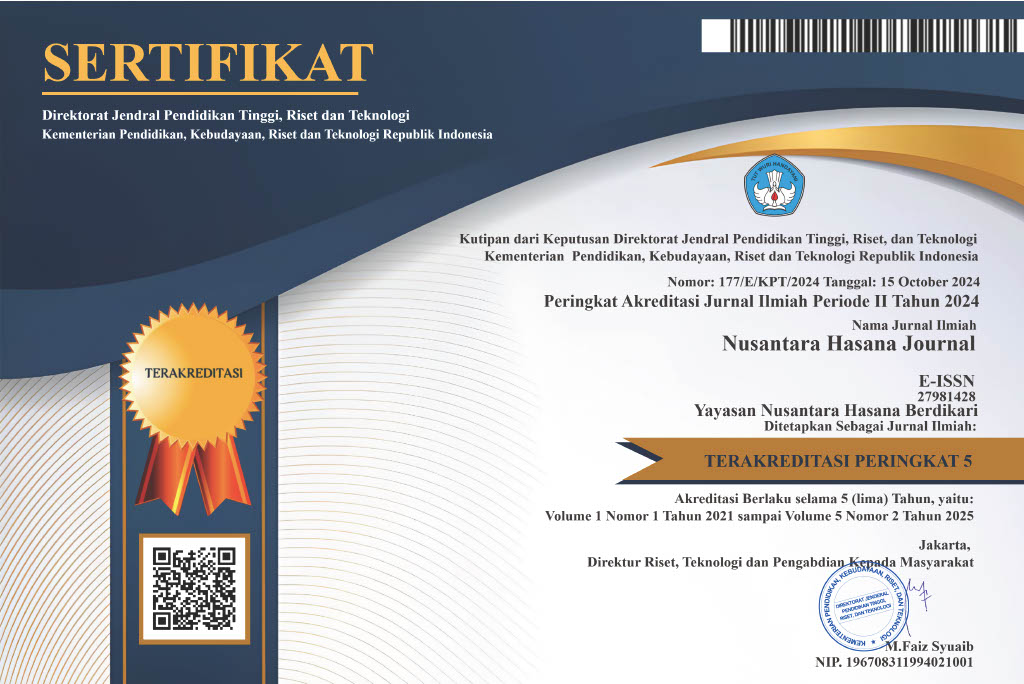PROFIL PASIEN BENIGN PROSTATIC HYPERPLASIA DI RSUP DR. M. DJAMIL PADANG TAHUN 2021-2023
DOI:
https://doi.org/10.59003/nhj.v4i9.1339Keywords:
Benign Prostatic Hyperplasia, PSA, LUTSAbstract
Benign Prostatic Hyperplasia (BPH) is a benign enlargement of the prostate gland that often occurs in elderly men due to prostatic stromal and epithelial hyperplasia. The prevalence of BPH increases with age, from 20% in men aged 40 years to 90% at age 80 years, with a global incidence reaching 11.26 million cases in 2019. Clinical symptoms in the form of Lower Urinary Tract Symptoms (LUTS) include irritation such as frequency, urgency, nocturia, and obstruction such as weak stream and hesitancy. Risk factors include age, family history, obesity, diabetes mellitus, and metabolic syndrome. Until now, there has been no data on the profile of BPH patients at Dr. M. Djamil Padang Hospital. Background :This study aims to determine the profile of benign prostatic hyperplasia patients at Dr. M. Djamil Padang General Hospital in 2021-2023. Methode : : This research covers the field of surgery, the type of research used is quantitative descriptive using secondary data. This design was used to view the profile of BPH patients at RSUP DR. M. Djamil Padang 2021 – 2024. Data collection was taken from medical record data. The sampling method was chosen using a simple random sampling technique. The data analysis used is univariate analysis. Result : The results of this study indicate that the highest number of BPH cases were found in the age group of 60-74 years as many as 29 people (54.7%), the highest PSA levels with a value of 0-2.5 ng/dl as many as 46 people (86.8%), the highest prostate volume was found 40-70 ml as many as 26 people (49.1%), the most common therapy performed was surgery as many as 51 people (96.2%), BPH patients who had a history of diabetes mellitus as many as 20 people (37.7%). BPH patients who had a history of hypertension as many as 13 people (24.5%) and there were no patients who had a family history of BPH. Kesimpulan : BPH cases are most often found in men aged 60-74 years. The most common therapy is surgery, especially Tranurethral Resection Prostate (TURP).
Downloads
References
Giannakis I, Herrmann TRW, Bach T. Benign Prostatic Hyperplasia (BPH). Urol Surg Digit Era Next Gener Surg Nov Pathways. 2021;1(2):3–38.
Permadi HA, Rachmawati M, Abdul Hadi Hassan. Karakteristik Klinis dan Histopatologi Pasien Benign Prostatic Hyperplasia di Rumah Sakit Angkatan Udara Dr. M. Salamun Kota Bandung Tahun 2020-2021. Bandung Conf Ser Med Sci. 2023;3(1):795–805.
Syifa S M. Tinjauan Pustaka Tinjauan Pustaka. Conv Cent Di Kota Tegal [Internet]. 2017;6–32. Available from: http://repository.umy.ac.id/bitstream/handle/123456789/10559/BAB II.pdf?sequence=6&isAllowed=y
Maulana DA. Faktor Yang Mempengaruhi Kejadian Batu Saluran Kemih Pada Pasien Benign Prostate Hyperplasia. J Penelit Perawat Prof [Internet]. 2021;3(3):603–10. Available from:http://jurnal.globalhealthsciencegroup.com/index.php/JPPP/article/view/557
Sutanto RL. Hiperplasia Prostat Jinak. JIMKI J Ilm Mhs Kedokt Indones. 2021;8(3):90–7.
Merani S, Payne J, Hudson D, Widder S. Predictors of in-hospital mortality and complications in very elderly patients undergoing emergency surgery. World J Emerg Surg. 2014;9(1):43.
Azizah Heru MJ, Kurniawati, Hamu AH, Sulfian W, Sari YK. Asuhan Keperawatan Sehat Jiwa. Nuansa Fajar Cemerlang [Internet]. 1967;(Mi):5–24. Available from: file:///C:/Users/Administrator/Downloads/ASKEP SEHAT JIWA FULL (1).pdf
Syahputra I, Purnanto E, Detty AU, Kumala I. Hubungan Diabetes Melitus Tipe II Dengan Kejadian Benigna Prostat Hiperplasia Di Rumah Sakit Pertamina Bintang Amin Bandar Lampung. MAHESA Malahayati Heal Student J. 2022;2(3):550–63.
Sutysna H. Tinjauan Anatomi Klinik Pada Pembesaran Kelenjar Prostat. Bul Farmatera. 2016;1(1):5.
Lakidende M. Profil pasien benign prostatic hyperplasia pada poli urologi rawat jalan dan rawat inap RSP Universitas hasanuddin periode Januari - Desember 2020. 2022;1–23. Available from: http://repository.unhas.ac.id/id/eprint/16224/2/C011181401_skripsi_bab 1-2.pdf
Haile ES, Sotimehin AE, Gill BC. Medical management of benign prostatic hyperplasia. Cleve Clin J Med. 2024;91(3):163–70.
Tang S, Huang L, Lin F, Chen X, Wang Y, Xu J, et al. Sex steroid and cognitive function among community-dwelling older men with or without vascular risk factors: a cross-sectional study. BMC Geriatr. 2024;24(1):1–9.
Cannarella R, Condorelli RA, Barbagallo F, La Vignera S, Calogero AE. Endocrinology of the Aging Prostate: Current Concepts. Front Endocrinol (Lausanne). 2021;12:1–13.
Cannarella R, Condorelli RA, Barbagallo F, La Vignera S, Calogero AE. Endocrinology of the Aging Prostate: Current Concepts. Front Endocrinol (Lausanne). 2021;12(February):1–13.
Lee MH, Shin YS, Kam SC. Correlation between testosterone replacement treatment and lower urinary tract symptoms. Int Neurourol J. 2021;25(1):12–22.
Beacham, B.L. & Deatrick JAMY, Keith R. Lohse, PhD, Catherine E. Lang, PT PhD, and Lara A. Boyd PP.NIH Public Access. Bone. 2008;23(1):1–7.
Breyer B, Sarma A. Hyperglycemia and Insulin Resistance and the Risk of BPH/LUTS: an Update of Recent Literature. Curr Urol Rep. 2014 Dec 1;15:462.
Prochaska J, Benowitz N. Hyperglycemia and Insulin Resistance and the Risk of BPH/ LUTS: an Update of Recent Literature Benjamin. Physiol Behav. 2016;176(1):100–106.
Dornbier R, Pahouja G, Branch J, Mcvary KT. Asosiasi Urologi Amerika Baru Prostat Jinak Pedoman Klinis Hiperplasia : Update 2019. 2020;1–10.
Liu X, Ma K, Yang L, Peng Z, Song P, Liu Z, et al. The relationship between depression and benign prostatic hyperplasia in middle-aged and elderly men in India: a large-scale population study. BMC Public Health [Internet]. 2023;23(1):1–9. Available from: https://doi.org/10.1186/s12889-023-17027-2
Sjamsuhidajat R, Jong DW. Buku ajar ilmu bedah. Edisi ke-3. Jakarta: EGC; 2011.
Gravas S, Bachmann A, Descazeaud A. Guidelines on the Management of Non-Neurogenic Male Lower Urinary Tract Symptoms (LUTS), incl. Benign Prostatic Obstruction (BPO). European Association of Urology; 2014
Ikatan Ahli Urologi Indonesia (IAUI). Panduan Penatalaksanaan klinis Benign Prostatic Hyperplasia. Jakarta: IAUI; 2017.
Purnomo BB. Buku Kuliah Dasar–Dasar Urologi. Jakarta: Infomedika;2012
Presti JC. Neoplasms of the Prostate Cancer.In: Tanagho EA, McAninch JW. Smith's General Urology, 16th edition. USA: The McGraw-Hill Companies; 2010. p.367-84
Mochtar CA, Umbas R, Soebadi DM, Rasyid N. Panduan Penatalaksanaan Klinis Pembesaran Prostat Jinak. Edisi ke-2. Jakarta: Ikatan Ahli Urologi Indonesia; 2015.
D'Silva KA, Dahm P, Wong CL. Does This man with lower urinary tract symptoms have bladder outlet obstruction?: The Rational Clinical Examination : A systematic review. JAMA. 2014;312(5):535‐42. doi:10.1001/jama.5555.
Bozdar RH, Memon RS, Paryani PJ. Outcome Of Transurethral Resection of Prostate in Clinical Benign Prostatic Hyperplasia. J Ayub Med Coll Abbottabad. 2010.
Gerber GS, Brendler CB. Evaluation of the Urologic Patient:History, Physical Examination, and Urinalysis. In: Campbell-Walsh Urology. 10th Edition. Philadelphia: Elsevier Saunders; 2012; p.71-80.
Yoshida M, J. K, Homma Y, Kawabe K. New clinical evidence of silodosin, an a 1A selective adrenoceptor antagonist, in the treatment for lower urinary tract symptoms. Int J Urol. 2012;19(4):306-
Downloads
Published
How to Cite
Issue
Section
License
Copyright (c) 2025 Mhd Nurhuda

This work is licensed under a Creative Commons Attribution-NonCommercial-ShareAlike 4.0 International License.
NHJ is licensed under a Creative Commons Attribution-NonCommercial-ShareAlike 4.0 International License.
Articles in this journal are Open Access articles published under the Creative Commons CC BY-NC-SA License This license permits use, distribution and reproduction in any medium for non-commercial purposes only, provided the original work and source is properly cited.
Any derivative of the original must be distributed under the same license as the original.
























